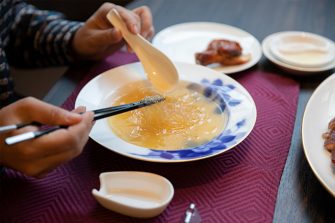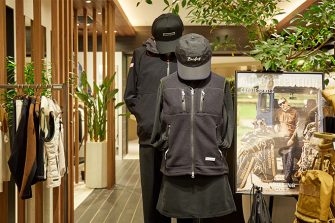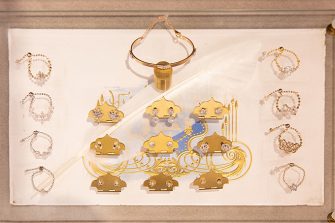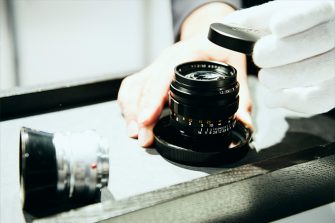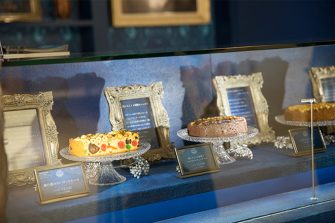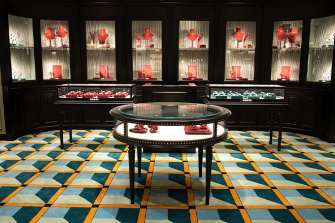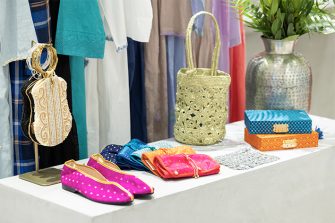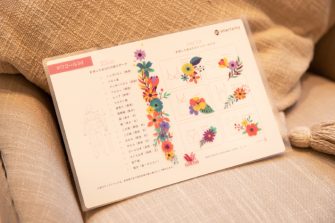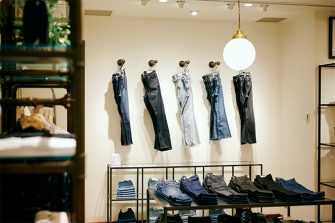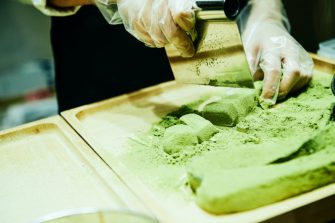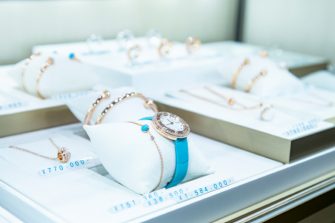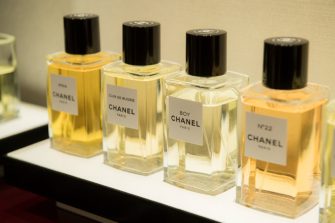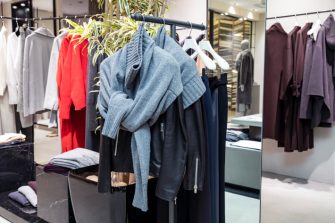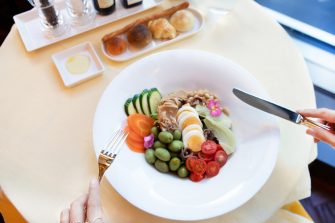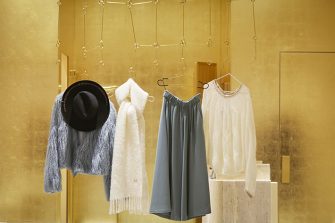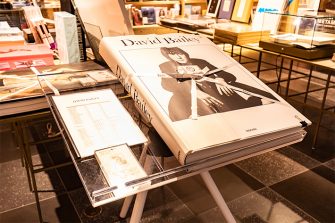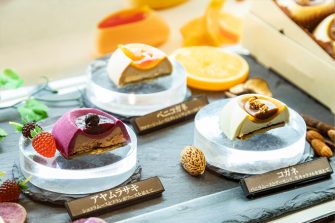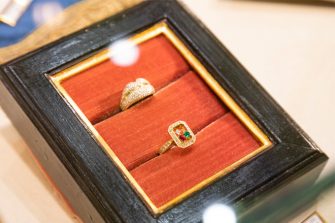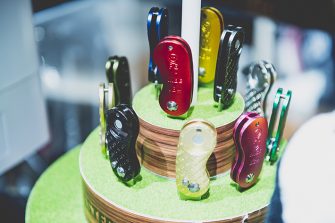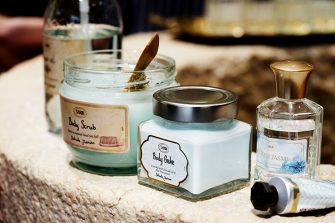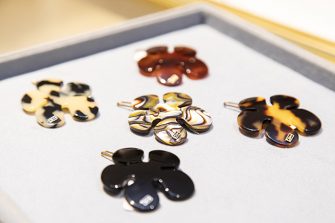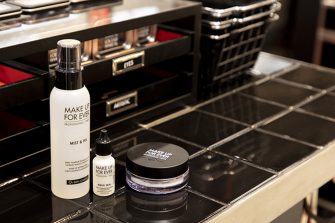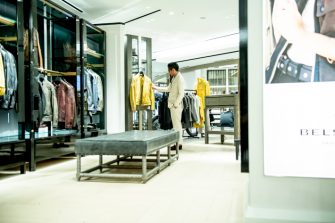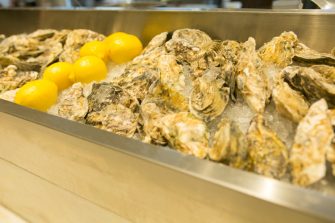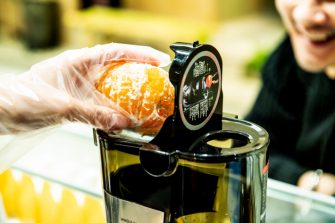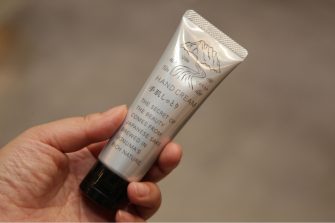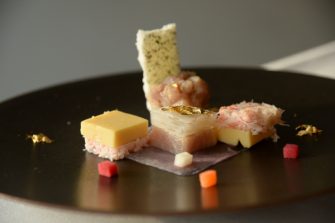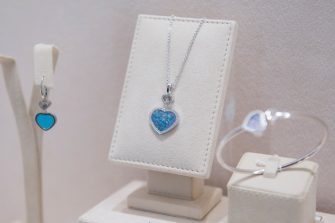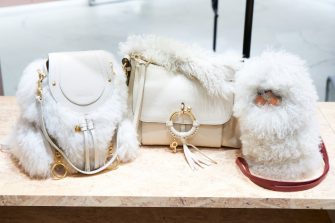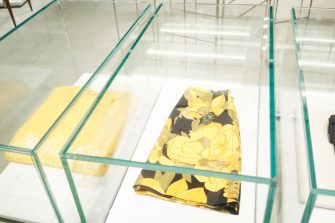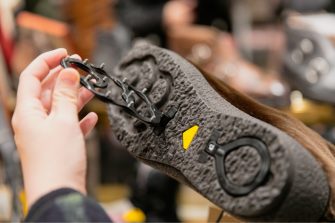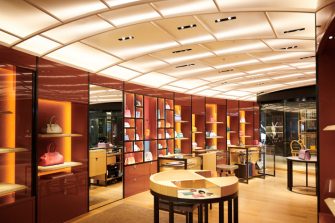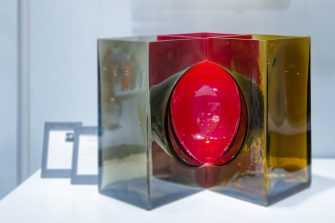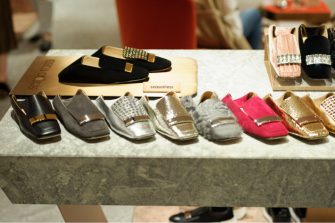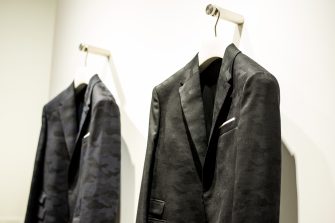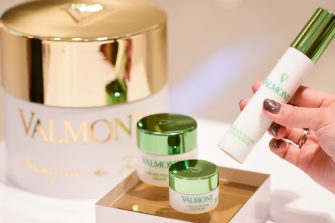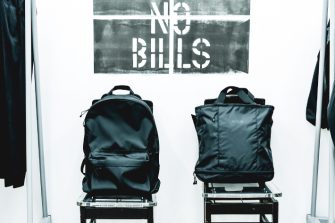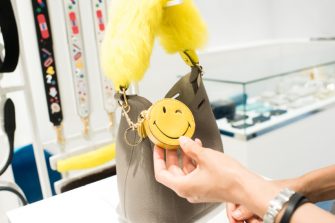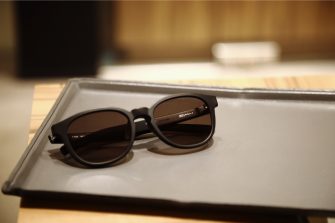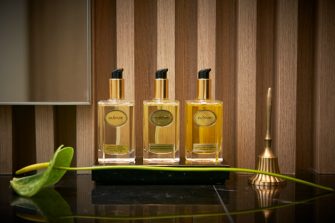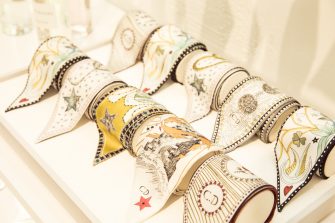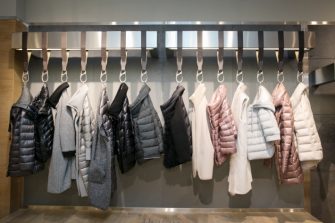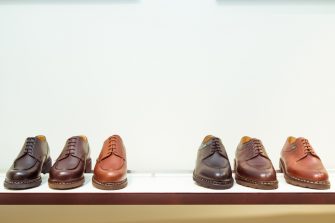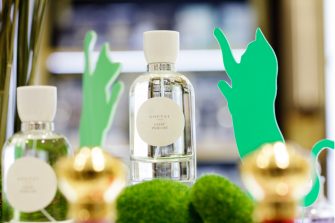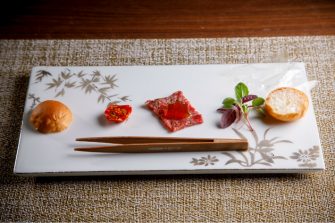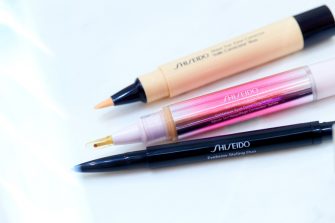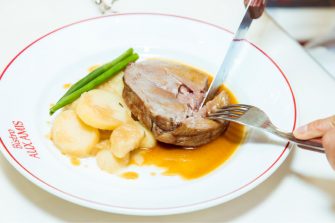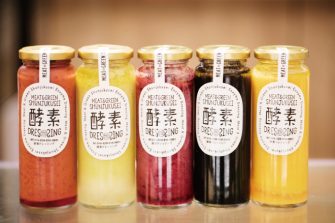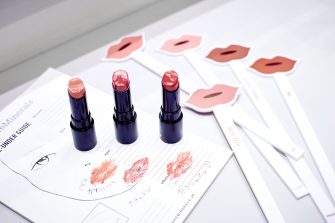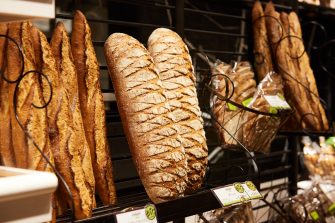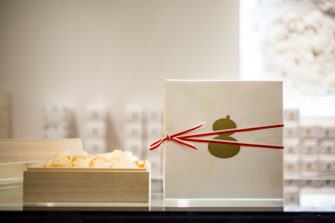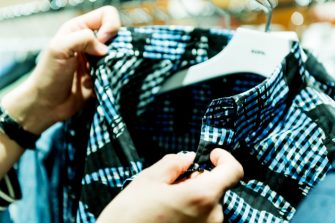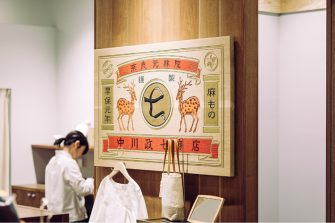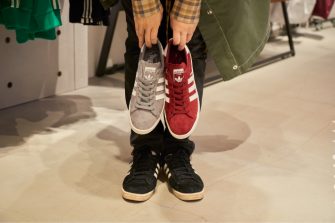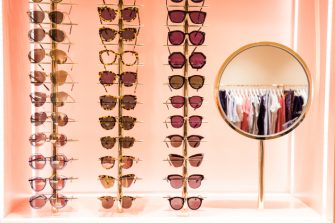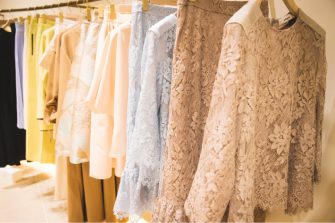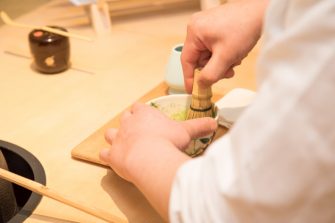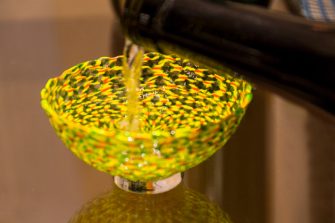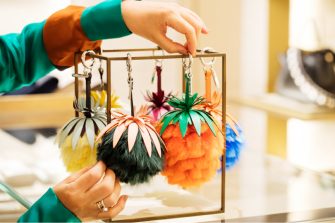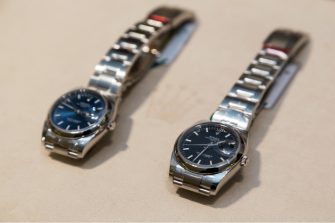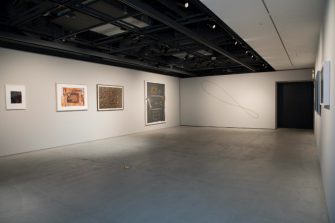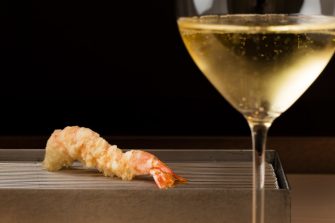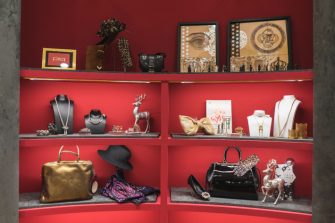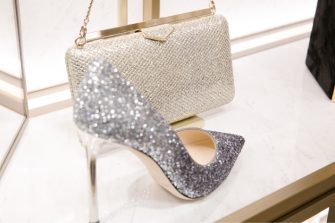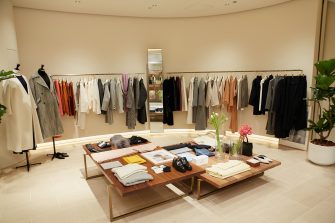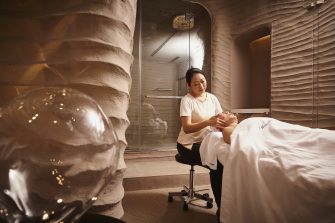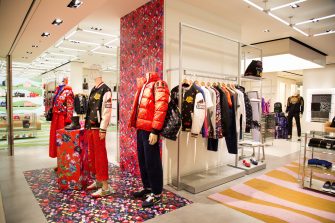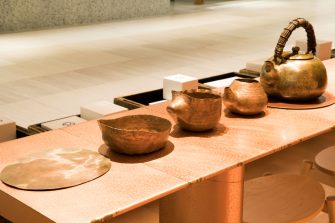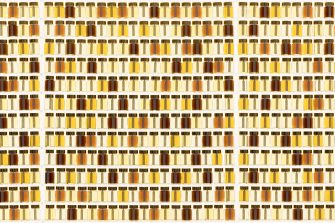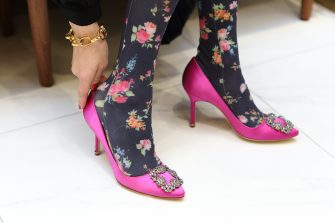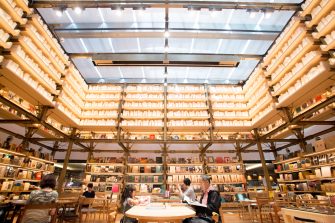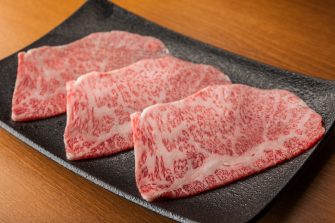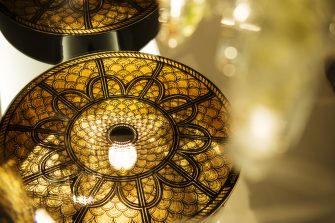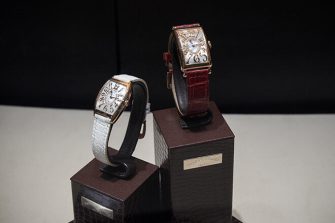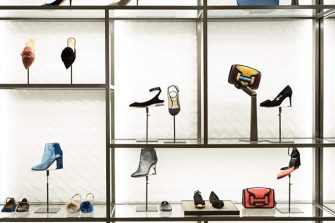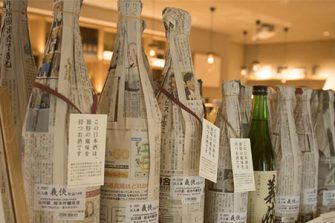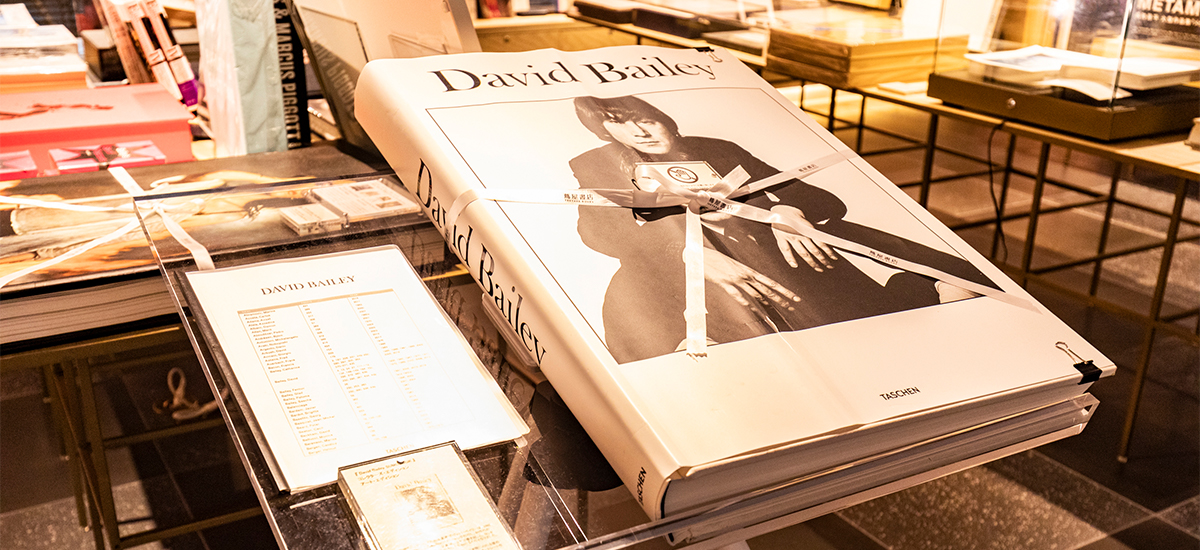

GINZA SIX EDITORS
ファッション、ジュエリー&ウォッチ、ライフスタイル、ビューティ、フード…
各ジャンルに精通する個性豊かなエディターたちが、GINZA SIXをぶらぶらと
歩いて見つけた楽しみ方を綴ります。
洗練と贅の楽しさを満喫する銀座のパワースポット A Power Spot in Ginza: Filling Up on Refined Luxury
藤岡 篤子
GINZA SIX EDITORS Vol.86
蒸し暑い東京にもそろそろ秋の気配が忍び寄る9月初旬。ヨーロッパのコレクション取材の直前だが、コレクションの下見?にGINZA SIXをぶらりと覗いてみた。クルーズコレクションやジャパンスペシャルがずらりと出揃うラグジュアリーなブティックが軒を連ねるGINZA SIXは、まるでパリのアヴェニューモンテーニュやミラノのモンテナポレオーネをそぞろ歩く楽しさだ。ファッションジャーナリストとして、頭に入れておきたい新しい情報が、目に飛び込んでくるし、思わず手にとって欲しくなるものもたくさん見つかる。誘惑と贅沢な体験に満ちた一時間半のショートトリップの始まりだ。
まず最初に訪れたのは蔦屋書店。
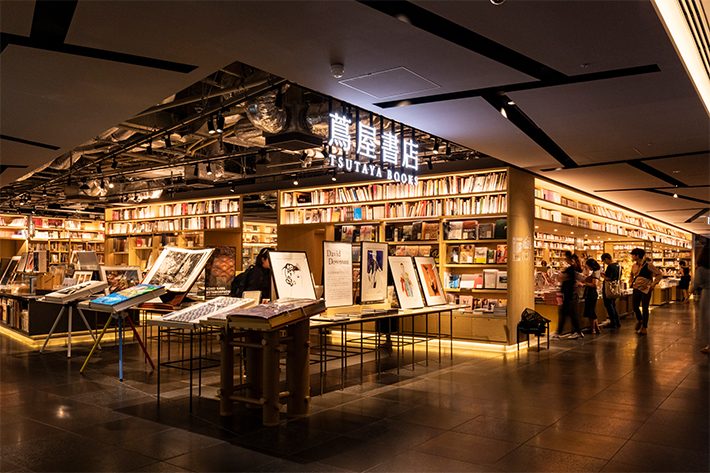
本の殿堂であり、ユニークな書籍の品揃えでも知られる蔦屋 銀座書店は、いつでも大のお気に入りだ。特にGINZA SIXで、訪れたいのがこの写真本のコーナー。特製の限定版がいつも何かしら置いてあり、頼めばこの日対応してくれた番場文章さんをはじめ、白い手袋をした写真コンシェルジュが丁寧な解説付きでページをめくってくれる。
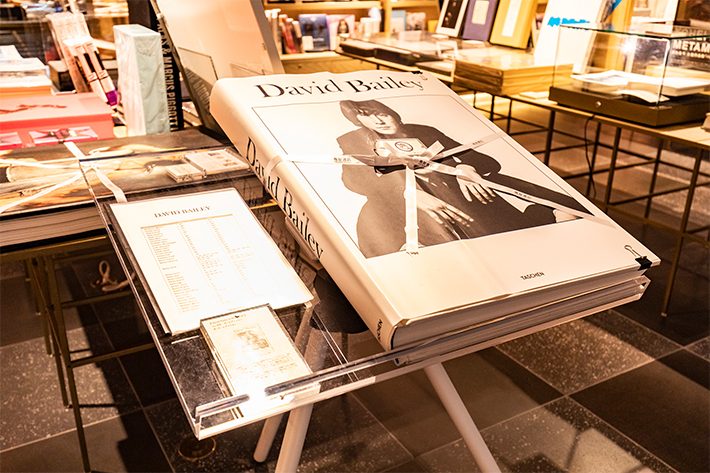
今回のお目当は、英国の写真家デヴィッド・ベイリーの写真集(390,000円 ※以下全て税抜価格)。この巨大なサイズをより見やすく、楽しめるように特注された「マーク・ニューソン」デザインのデスクに置かれ(なんと写真集とデスクはセット売りだ) 、写真コーナーのエントランスを飾っている。ファッションを志し、うっとりと白黒の写真集を穴があくほど眺め、ロンドンに、ファッションに憧れた遠い時代、デヴィッド・ベイリーは、私のヒーローだった。階級制度が根強く残っていた英国で、魚屋の息子がトップフォトグラファーとして、世界のファッション誌を制覇し、サブカルチャーの主役に躍り出たのは、まさに60年代的なサクセスストーリーであり、古い体制社会が音を立てて崩れる、そんなロンドンのポップカルチャーの体現者であった。

60年代から現在に至るまで時代別に区切られた編集で、その時代に輝いたセレブリティを白黒でシャープに、時としてユーモラスに切り取った写真は、何回見ても飽きることがない。というより、何時間見ていても泉のようにイマジネーションが湧き出て、尽きるどころか、写真が、被写体の人生まで語り出す。
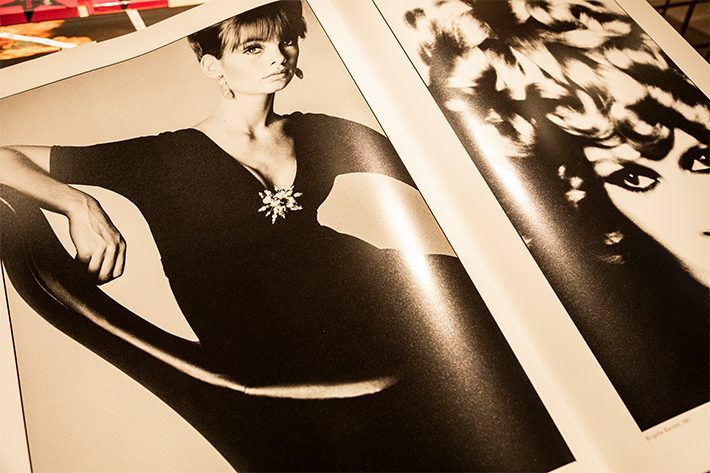
デヴィッド・ベイリーの恋人であるとともに60年代を制覇したスーパーモデルのジーン・シュリンプトン。日本ではツィッギーの方が有名だが、世界的にも、当時のファッション誌では、断然ジーンがビッグであった。あのアメリカンヴォーグの名編集長ダイアナ・ブリーランドが、ジーンが、ずぶ濡れになって初対面に駆けつけた時、「まあ完璧なかわい子ちゃんだわ」というセリフを吐いたと言われる。パスポートの写真ですら完璧に美しかったと言われるスィンギングロンドンの伝説的ミューズだ。デヴィットが撮り下ろしたジーンとのファッションフォトは雑誌のカバーを飾った無数の傑作があり、一部がこの写真集に収められている。デヴィッド・ベイリーは、ジーンと別れた後、カトリーヌ・ドヌーヴと結婚し、その後別れた。

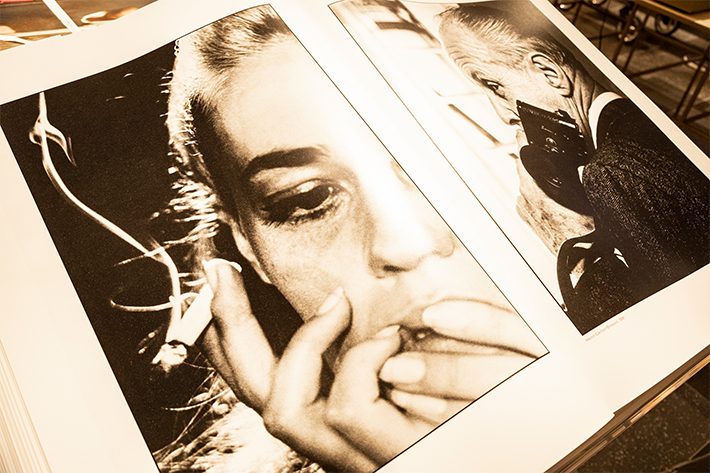
あ〜ここにもフェデリコ・フェリーニ(監督)とマストロヤンニが、ここにはジャンヌ・モローが!!とページをめくるたびに、デヴィッドのエッセンスがこぼれ落ちるように放たれ、どのポートレートを見ても、思わず笑みがこぼれてしまう。いつまでも眺めていると、そろそろ時間が…とせかされ、しぶしぶ次のページに。

ファッションとサブカルチャーは強い結びつきがあり、写真、音楽、文学、アート、ダンス様々な要素がクリエイターを刺激する。着想源の一つが60年代、70年代であり、その時代を象徴する人物が、キャラクターにふさわしい切り撮られ方をした写真は、被写体以上に本質を表現し、時には事態を予測したりする。目下公開中の話題の映画『ワンス・アポン・ア・タイム・イン・ハリウッド』に登場した「シャロン・テート事件」(※1969年にその夫だったロマン・ポランスキー監督の豪邸で、彼がロンドンで撮影中、妊娠8か月だったシャロンと、一緒にいた彼女の元婚約者で有名ヘア・デザイナーのジェイ・セブリングら友人が、殺害された事件)の主人公女優シャロン・テートは短い結婚生活を、監督ロマン・ポランスキーと送ったが、悲劇が襲う前の、二人の幸せの絶頂がこの写真一枚に語り尽くされている。犯人がカルト集団の教祖チャールズ・マンソンとファミリーだったというのも、ヒッピーがカルト化した時代背景を感じさせる。
気分を変えて、次はイタリアのゴージャスなシューズブランド「GIUSEPPE ZANOTTI(ジュゼッペ ザノッティ)」へ。
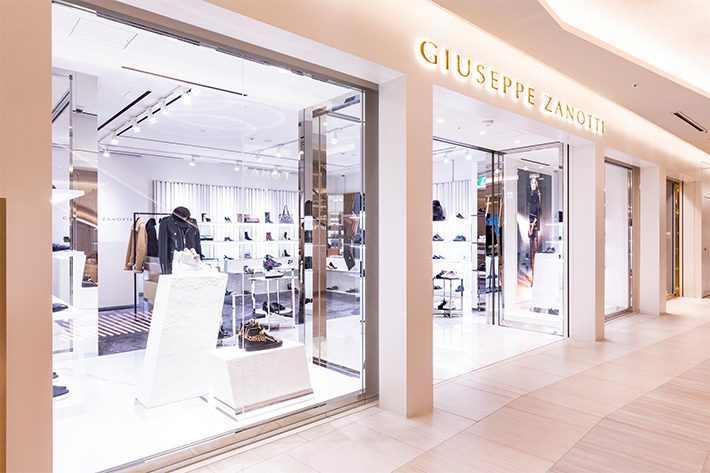
ミラノコレクションの時のモンテナポレオーネ通りの賑わいときたら、もう華やかで、アロマの良い香りが漂い、いつまでも住人のような顔をして通りで立ち話をしていたいほどだ。中でもひときわ人だかりが絶えないのが「ジュゼッペ ザノッティ」のブティック。GINZA SIXのブティックにも、その贅を尽くしたアイコニックなシューズがずらりと並ぶ。
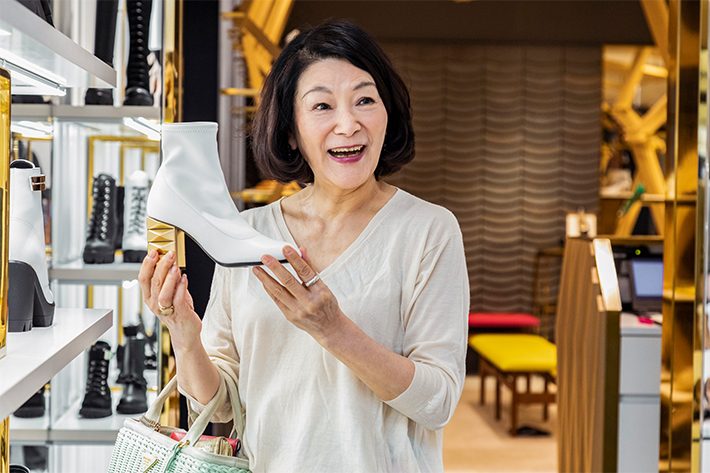
ザノッティといえば、これでしょう! ゴールドのメタルヒールに刻印を押したような凹凸模様が刻まれている白いブーツ。これだけ華やかな「白×ゴールド」という組み合わせが、シンプルに見えるのは洗練というジュゼッペ・ザノッティの魔法がかけられているから。冬に白いブーツを履くという粋さ。この一足があれば、どんな着こなしもお洒落なミラノマダム流に変貌してしまいそう。
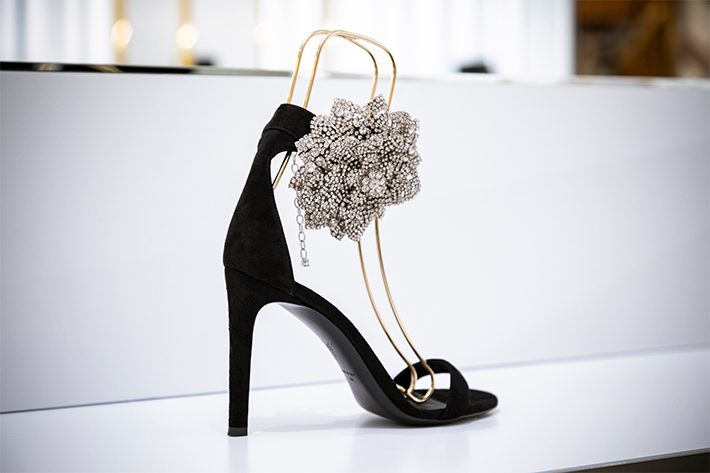
ジュゼッペ ザノッティの魔法その2。この輝きこそ、このブランドの真髄だ。モンテナポレオーネのショールームで開催される展示会でも、毎シーズン欠かさず、提案されてくるのが、絢爛と足元を彩るジュエリーシューズ(上写真は220,000円)だ。手の指にダイアモンドの指輪をするように、足元も、優美なジュエリーで装いたい。それも周りの人たちが息を飲むような華麗さで。レッドカーペットやイブニングにジャストフィットする眩しいほどの大輪の花の輝きが足首に光る。どういう人たちが、どんなドレスでこの靴を合わせるのだろう? 想像するだけでも、テンションが上がる。特別な時のためのとっておきのジュエリーシューズだ。
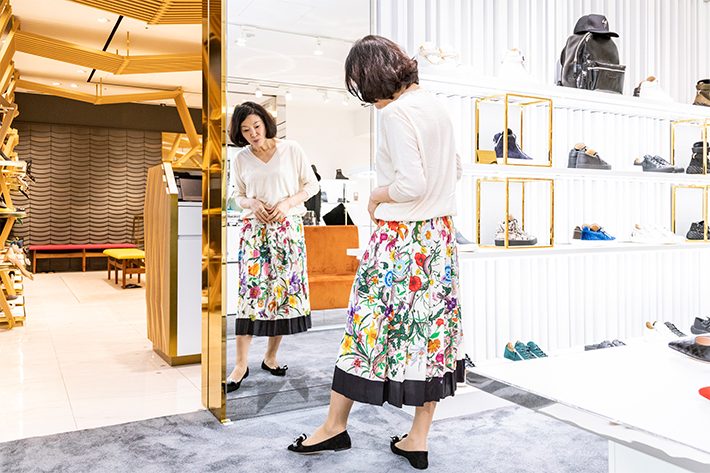
ジュゼッペ ザノッティ魔法その3。とうとう誘惑に負けそうになった。「お試しだけでも」という言葉に、ザノッティのラインアップの中では、比較的タウンユースの黒のフラットシューズ(105,000円)を選択。爪先にはシルバーのラインストーンのリボンが付いていて、ザノッティの香りが強く漂う。なんと、この時着ていたセーターとプリーツスカートという自分の定番ルックにも、似合うではないか…。イブニングドレスだけではなく、普通の街着にも、素敵に履きこなせるという発見。ザノッティの魅惑の世界にもうノックアウト。
イタリアブランドは、やはり女性の心を鷲掴みにする。導かれるように次は「FENDI(フェンディ)」のブティックへ。

ローマの毛皮の老舗フェンディ。GINZA SIXでも銀座中央通り添いのコーナーにブティックを構えている。1925年の創業だが、5人の娘たちが後継者となってさらにモダンな味わいに発展させ、現在は三代目にあたるシルヴィア・フェンディがデザイン分野を担当している。1965年に弱冠27歳であったカール・ラガーフェルドと契約し、その54年間という長きに渡るコラボレーションはフェンディの歴史の「華」である。残念ながら今年の2月フェンディのコレクションショーの2日前にカール・ラガーフェルドは逝去したが、最後まで電話でコレクションへの指示を出していたという。誰も亡くなるなど予想もしなかった突然の出来事であった。カールの偉業を讃え、ショーの最後に流れたデヴィッド・ボウイの「HERO」が、今も耳に残る。今回ブティックを訪れた理由の一つは、1981年にカールが自筆で書いた「カリグラフィ(文字を美しく見せる書法、日本での書道に近い)」によるFFロゴ「カーリグラフィー」がいくつかのアイテムに商品化されて展開されているという情報を聞きつけたからだ。ファーのコートから、バッグのバックルに至るまでありました! まるでカールの最後のメッセージのように、気品高く、存在感のあるFFロゴ「カーリグラフィー」は、一つは絶対に持っていたいカール・ラガーフェルドが後世に遺した贈り物ではないかと思う。
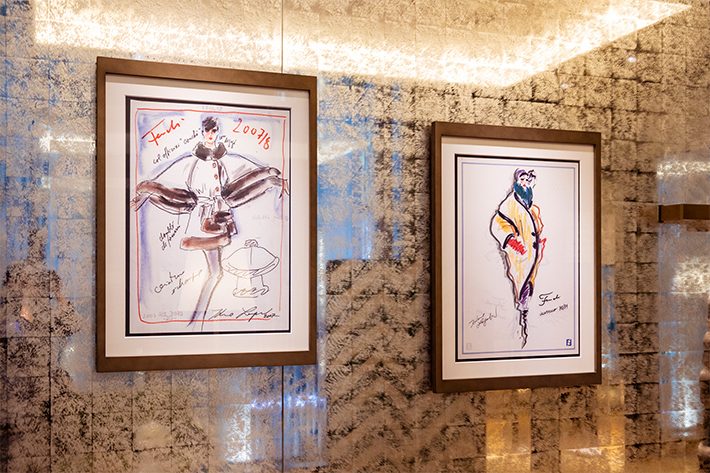
カール・ラガーフェルドの華麗なスケッチが、VIPルームに通じるエレベーターにも飾られ、フェンディとの強い絆を感じさせる。カール特有のキッチュな配色や流麗なスケッチは、フェンディに永遠の命を吹き込んでいる。
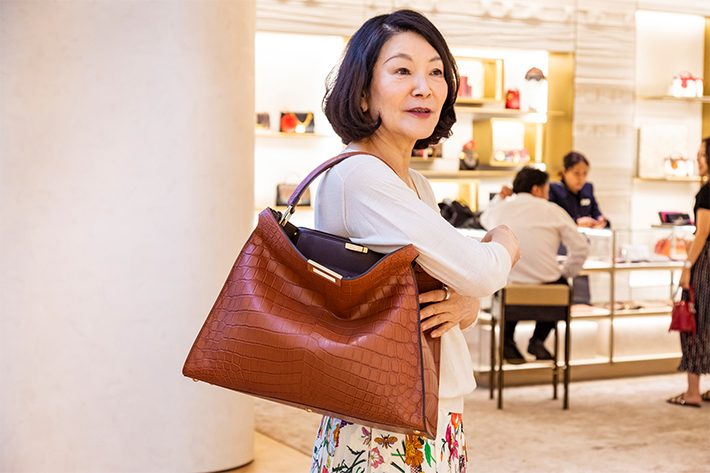
ただいま絶大な人気を誇るバッグ「ピーカブー エックスライト」にクロコダイル製のビッグサイズ(3,500,000円)が出現。書類もバンバン入り、仕事にも使い勝手が良さそうな大きさに、思わず手が伸びる。明るいブラウンのクロコダイルは、どんなスタイルにも、しっくり似合い幅広く使えそうだ。驚くほど軽量に仕立てられ、さすが職人技が光るフェンディならではのメゾンの奥深さを感じさせる。
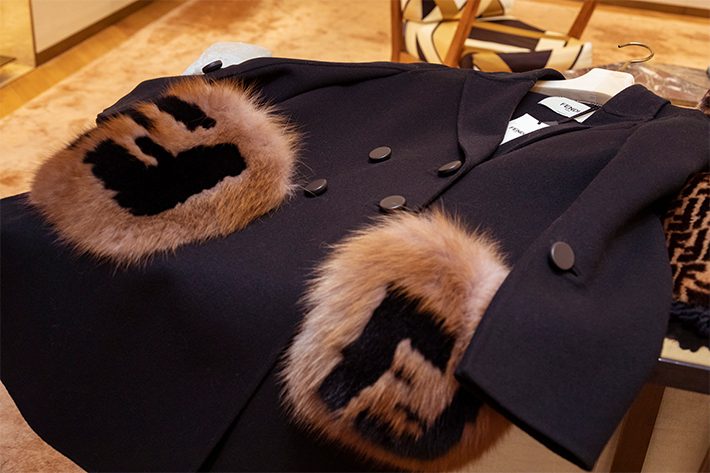
相変わらず人気が高いのがフェンディの歴史とともにある、このFFロゴだ。1969年に毛皮コートのプレタポルテを発表し、その時まで裏地に用いられていたFFロゴを初めて表側に使い、以来ブランドを象徴するアイコンとなった。人気バッグのバゲットを始め、ジャカードやプリント使い、またファーアクセントとして様々なアイテムに用いられている。このテーラードコート(516,000円)は、ゴージャスにユーモラスにFFロゴの毛皮のポケットがアクセントになっている。
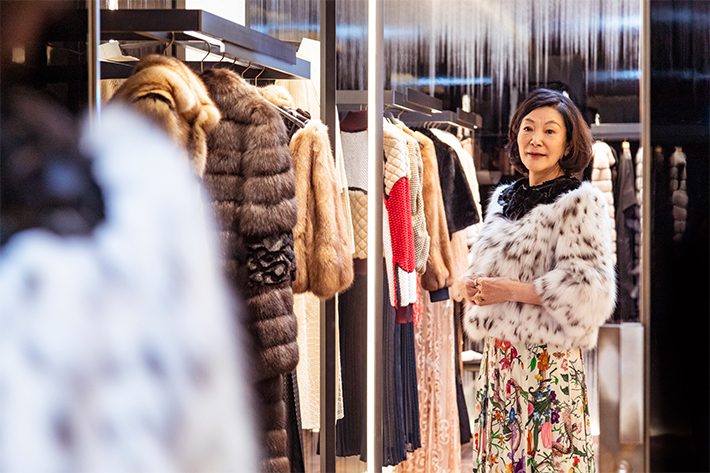
やっぱりフェンディに来たなら、メゾンのアイコンである最高級の毛皮を手に通してみたい…。柔らかな毛足の感触に包まれ、心も身体も癒されるような幸せ。そう思うのは女性なら誰しも共感できるのではと思う。丁寧に着れば100年は持つとも言われ、親子三代着用した後は土にも還る。4FのVIPルームで、専属の毛皮エキスパートのアドバイスを受けながら、あれこれ手を通して見るのは、まさに至福の時である。この白黒のブルゾン(23,681,000円)は、格調の高さはイブニングにはもちろん、意外にスポーティなジーンズにも合いそう。とは言え、最高級のボブキャットを使い、ここまでカジュアルなデザインに落とし込むとは、センスと技術の両輪を備えるフェンディの素晴らしさにますます魅了されていく。
ミラノやパリのラグジュアリーブランドの最高峰を短時間で何軒も訪れることができ、丁寧で行き届いた接客態度に、商品の品質の高さだけではない老舗の底力を味わう醍醐味。それは海外の有名な通りだけではなく、GINZA SIXでも味わえる稀有な体験だ。私は、ブランドの真の力とは、技術だけでも、デザインだけでもないブティックの対応も含めた総合力の高さにあると信じている。そのクオリティの高さを実感できるGINZA SIXは、そぞろ歩くだけでも、贅沢なオーラを浴びることができそうな、ひょっとしたら銀座のパワースポットのような存在かもしれない。
Text:Atsuko Fujioka Photos:Kanako Noguchi Edit:Yuka Okada(edit81)
It’s hot and humid here in Tokyo in early September, but signs of fall are beginning to seep into the air. Soon I’ll be on my way to Europe to cover Fashion Week, but today I chose to stroll around GINZA SIX—lined with luxury boutiques displaying cruise collections, Japan specials, and more, all arranged side by side—and maybe get an advance peek. It feels much like taking a stroll down Avenue Montaigne in Paris or Via Monte Napoleone in Milan. As a fashion journalist, I’m always on the lookout for new information. There’s so much here to catch the eye. I feel I want to pick things up without thinking and find so much I would personally like to own. And in this way begins a short hour-and-a-half trip filled with luxury and enticements.
I first visit Ginza Tsutaya Books, a palace of books.

The GINZA SIX location in particular is known for its collection of unique titles. It’s my perpetual favorite. Whenever I’m here, I browse the photography section, where you’ll always find special limited editions. If you inquire, a store’s white-gloved photography concierge will turn the pages for you while providing helpful explanations. My concierge today is Fumiaki Banba.

On this occasion, I’m after a photography collection from the English photographer David Bailey (390,000 yen; all prices listed before tax). To make it easier to leaf through and enjoy this huge book, it’s displayed on a custom desk designed by Marc Newson (amazingly, the book and desk are sold together!), which is positioned at the entrance of the photography section. In the distant past, seeking out and pining for fashion and London, I’d gaze intently into his black-and-white photos, all but boring holes through them. David Bailey was my hero in the London of that distant time.
In Britain, when the class system remains fairly entrenched, a fishmonger’s son conquered the world’s fashion magazines as the industry’s top photographer and became a major figure of the counterculture—truly a 60s success story. He was the embodiment of pop culture in London at a time when the establishment was tumbling down.

The book is divided by era, from the 1960s to the present. The photos of the leading celebrities of the day are sharp black-and-whites, sometimes whimsically cropped. You look at them again and again and never tire. Or, perhaps it’s better to say, you can study them for hours. They’re materials from which the imagination springs; will the source ever run dry? The photos almost speak the lives of their subjects.

Jean Shrimpton, supermodel and erstwhile lover of David Bailey, was also a conqueror of the 60s. Twiggy may have been more famous in Japan, but globally, in the fashion magazines of the time, Shrimpton was by far the more prominent figure. When Shrimpton rushed in, soaking wet, and met Diana Vreeland, famed editor-in-chief of American Vogue, for the first time, Vreeland reportedly cried out, “Adorable!” Shrimpton was the legendary muse of Swinging London; even her passport photo was perfect, it’s said. Among the fashion shots of Shrimpton taken by Bailey that graced magazine covers are innumerable masterpieces. You’ll find a selection of these in this volume. After his relationship with Jean Shrimpton ended, David Bailey married Catherine Deneuve; they later divorced…


Oh, here’s Federico Fellini, the director, and Marcello Mastroianni, and here’s Jeanne Moreau! Every time I turn the page, I encounter, once again, brimming from every page, the essence of Bailey’s vision. Every portrait I look at makes me smile. I could study each one forever—but the time, the time… I feel rushed and turn the pages reluctantly.

Fashion has strong ties to counterculture: photography, music, literature, art, dance—all these modes of expression stimulate creative individuals. The 60s and 70s are themselves a fount of inspiration. The photos that transformed the symbolic figures of these decades into icons express something beyond their subject matter. At times, they presaged what was to come. The much-discussed film Once Upon a Time in Hollywood, currently in theaters, takes up the 1969 murder of actress Sharon Tate, in which Sharon, eight months pregnant, and several friends, including her former fiancé, celebrity hair stylist Jay Sebring, were murdered in the mansion of the director Roman Polanski, Tate’s husband, while he was away in London shooting a film. Tate hadn’t been married to Polanski for long. The photo here shows them when they were perhaps at their happiest, before tragedy struck. She was murdered by members of the Manson Family, a cult led by Charles Manson. The photo gives a sense of this historical backdrop, a time when the hippy movement began tilting towards cultism.
Needing a change of pace, I next go to Giuseppe Zanotti, a gorgeous Italian shoe brand.

During Milan Fashion Week, there’s great vibrancy and glamour on Via Monte Napoleone. Perfume drifts through the air. I could chat there on the streets forever, as if I actually lived there. There’s an unending stream of people at the Giuseppe Zanotti boutique in particular. At the GINZA SIX boutique as well, you’ll find rows of iconic shoes that express peak glamour.

This is what Zanotti is all about! These white boots have metallic gold heels with a patterned uneven surface, as if they’d been embossed. Giuseppe Zanotti’s magical powers of sophistication give a simple look to this stunning combination of white and gold. It’s chic to wear white boots in winter. Wearing these, no matter what else you wear, will transform you into a Milanese sophisticate.

Giuseppe Zanotti’s second magical power is to make sparkle itself the essence of the brand. Without fail, at the showroom in Via Monte Napoleone each season, he sets out jeweled shoes that confer brilliance upon every step (above photo: 220,000 yen). As diamond rings are for fingers, these shoes are exquisite jewelry for the feet. They’re gorgeous in a way that makes the people around you catch their breath. The large, dazzling flower, apparently created to grace the red carpet or a special evening occasion, sparkles on the ankle. Who would wear these shoes? What dress would they wear? The thought buoys my spirits. You’ll want to keep these jeweled shoes for special occasions.

This is the third magical power of Giuseppe Zanotti. I find myself succumbing to temptation. “Feel free to try a pair on,” says an encouraging voice. With that, I choose a pair of black flats (105,000 yen) from the Zanotti lineup, more or less intended for ordinary outings. There’s a ribbon of rhinestones on the toe; there’s an intense sense of Zanotti’s spirit in the air. By chance, they go pretty well, I think, with the sweater and pleated skirt I happen to be wearing, my signature look. I discover the shoes look great not just in evening dress, but with the clothes in which I regularly venture out into the world. The enticing world of Zanotti is a knockout.
Italian brands really grab hold of a woman’s heart. And, as if drawn by magic, I go next to Fendi.

Fendi, a long-standing proprietor of fur and leather goods, operates a boutique in the corner of GINZA SIX along Ginza Chuo Avenue. Founded in 1925, the shop was passed down to the founder’s five daughters, who expanded it with modern styles. Currently, its creative director is Silvia Fendi, from the family’s third generation. Karl Lagerfeld joined the company in 1965 at the tender age of 27: this 54-year collaboration is the great glory of Fendi’s history. Regrettably, Karl Lagerfeld passed away this year in February, two days before Fendi was to show its collection. He reportedly was giving instructions over the phone until the very end. It happened suddenly; no one expected it. David Bowie’s “Heroes” played at the end of the show to honor Karl’s prodigious achievements. It still rings in my ear. One reason I came to Fendi today was I’d heard that a number of items incorporated the FF logo based on the calligraphy handwritten by Karl in 1981. And, indeed, from fur coats to handbag buckles, this turns out to be true! It’s somewhat like Karl’s last statement. Highly refined and with an affecting presence, this FF calligraphy is perhaps a gift Karl Lagerfeld has bequeathed us. I definitely want something with this logo.

His gorgeous sketches are displayed in the elevator leading to the VIP room. The strong bond with Fendi is palpable. His distinctive kitsch color schemes and flowing sketches breathe eternal life into the brand.

Peekaboo X-Lite, a hot handbag line at the moment, is now available in a large-sized crocodile leather bag (3,500,000 yen). The large dimensions make it ideal for carrying numerous documents, and it looks versatile enough for work. I reach for it without thinking. The bright, brown crocodile leather goes well with any style. One could carry it with all sorts of looks, and it’s surprisingly light. The splendid craftsmanship gives a strong sense of Fendi’s depths as a fashion maison.

The FF logo, an integral part of Fendi’s history, remains as popular as ever. Initially used in the liners, it first appeared in 1969 with Fendi’s prêt-à-porter fur coat collection, becoming an icon of the brand thereafter. Starting with the popular Baguette handbag, it’s woven into various items in Jacquard fabric and prints and occurs as a fur accent as well. This tailored coat (516,000 yen) is accented with gorgeous, whimsical fur pockets bearing the FF logo.

Anyone coming to Fendi would want to run their hands through the maison’s iconic top-of-the-line fur. Wrapping yourself in soft fur exercises a soothing magic over both body and mind. It’s a kind of happiness to which all women can surely relate. If you’re reasonably careful, the fur will last 100 years, I’m told. Three generations will wear it, after which it returns to the earth. In the fourth floor VIP room, I get advice from the fur expert on hand. Seeing various furs and running your hands through them is the ultimate experience. The refinement of this black and white blouson (23,681,000 yen) makes it perfect, of course, for special evenings; but it would also go surprisingly well with a pair of sporty jeans. Having said this, the use of high-grade bobcat fur in a casual design speaks to Fendi’s wonderful combination of sensibility and technique. The brand feels all the more appealing.
GINZA SIX offers the opportunity to visit, in a short span of time, the pinnacles of Milanese and Parisian luxury brands. The customer service is thoughtful and attentive. It’s a real pleasure to experience the underlying strength of these long-standing brands—brands that are about so much more than the quality of their products. It’s a rare experience one can experience not just on famed shopping boulevards overseas, but at GINZA SIX. The true strength of a brand isn’t just technique, and it isn’t just design. I’m convinced it’s the high standard for overall capabilities, including the service customers receive at its boutiques. You can experience this exalted quality at GINZA SIX while strolling about and soaking up this aura of luxury, as if you were at a power spot in the heart of Ginza.
Text:Atsuko Fujioka Photos:Kanako Noguchi Edit:Yuka Okada(edit81)
藤岡 篤子
国際羊毛事務局(IWS)婦人服ファッションコーディネーターを経て、ファッションジャーナリストとして活動を開始。朝日新聞、毎日新聞、AERA、FIGARO japonなど、新聞からファッション誌まで幅広いメディアに執筆。また、連載は25ans、GINGER、GIZELEなどの日本のファッション誌にとどまらず、中国版RayやGlamorousなどにも掲載中。情報知識辞典「イミダス」のファッション分野の執筆編集も担当し、ケータイ版イミダス(http://imidas.jp)でファッション用語を解説する「花のランウェイ」は大人気。専門用語を分かりやすく解説する原稿には定評があり、家電、化粧品など異業種企業、団体等の講演も多い。年2回開催される「藤岡篤子ファッション・トレンド速報セミナー」は、編集者、アパレルのバイヤーやデザイナーなどを中心に高い評価を受け、日本一の動員数となっている。著作『買い手が変われば売り手が変わる』(日本能率協会)。社団法人日本流行色協会ファッションアドバイザー。日仏協会 理事。2016年度より、神戸芸術工科大学芸術工学部ファッションデザイン学科客員教授に就任。


